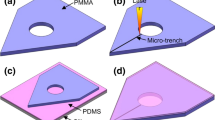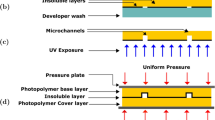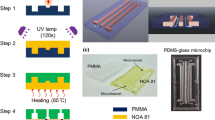Abstract
There are variety methods and materials for fabrication of the master mold for microfluidic system. In this report, two simple low-cost methods for fabrication of master molds for microfluidic chips are described and compared in quality of molds, thickness and resolution of micro-channels, design complexity, error tolerance and executive time. The first approach can create a master mold just in 5 min by using cutting plotter to cut the design out from vinyl adhesive paper based on the previous design; after that, the assembly attached into the petri dish to fabricate the complete mold. The second one is using nail polish meth(acrylates) (MA) gel as photoresist material to alter expensive SU-8 photoresist in soft photolithography technique and LED-UV light. These processes are simple, short time prototy**, inexpensive materials and no requirement for sophisticated equipment. Both methods can achieve the channels with the depth up to 80 μm. However, the channels of UV gel method are less affected by changes in temperature which enables more complex design as narrow as 200 μm in width compared to 500 μm of craft cutter method. The comparison of two proposed methods shows that UV gel satisfies the important demand for microfluidic master mold fabrication: low cost, possibility of more complex pattern in short time (15 min).
Access this chapter
Tax calculation will be finalised at checkout
Purchases are for personal use only
Similar content being viewed by others
References
Whitesides, G.M.: The origins and the future of microfluidics. Nature 442(7101), 368 (2006)
Khademhosseini, A., Langer, R.: Microengineered hydrogels for tissue engineering. Biomaterials 28(34), 5087–5092 (2007)
Ren, K., Zhou, J., Wu, H.: Materials for microfluidic chip fabrication. Acc. Chem. Res. 46(11), 2396–2406 (2013)
Martinez, A.W., Phillips, S.T., Butte, M.J., Whitesides, G.M.: Patterned paper as a platform for inexpensive, low-volume, portable bioassays. Angew. Chem. Int. Ed. 46(8), 1318–1320 (2007)
Sollier, E., Murray, C., Maoddi, P., Di Carlo, D.: Rapid prototy** polymers for microfluidic devices and high pressure injections. Lab Chip 11(22), 3752–3765 (2011)
Lin, C.H., Lee, G.B., Lin, Y.H., Chang, G.L.: A fast prototy** process for fabrication of microfluidic systems on soda-lime glass. J. Micromech. Microeng. 11(6), 726 (2001)
Nge, P.N., Rogers, C.I., Woolley, A.T.: Advances in microfluidic materials, functions, integration, and applications. Chem. Rev. 113(4), 2550–2583 (2013)
McDonald, J.C., Whitesides, G.M.: Poly (dimethylsiloxane) as a material for fabricating microfluidic devices. Acc. Chem. Res. 35(7), 491–499 (2002)
Nguyen, N.T., Wereley, S.T.: Fundamentals and Applications of Microfluidics. Artech House (2002)
Rothschild, M.: Projection optical lithography. Mater. Today 8(2), 18–24 (2005)
Whitesides, G.M., Ostuni, E., Takayama, S., Jiang, X., Ingber, D.E.: Soft lithography in biology and biochemistry. Annu. Rev. Biomed. Eng. 3(1), 335–373 (2001)
**a, Y., Whitesides, G.M.: Soft lithography. Annu. Rev. Mater. Sci. 28(1), 153–184 (1998)
Yuen, P.K., Goral, V.N.: Low-cost rapid prototy** of flexible microfluidic devices using a desktop digital craft cutter. Lab Chip 10(3), 384–387 (2010)
Acknowledgements
This research is funded by International University – VNUHCM under grant number T2017-02-BME.
Conflict of Interest The authors declare that they have no conflict of interest.
Author information
Authors and Affiliations
Corresponding author
Editor information
Editors and Affiliations
Rights and permissions
Copyright information
© 2020 Springer Nature Singapore Pte Ltd.
About this paper
Cite this paper
Thach, H. et al. (2020). Comparison of Nail Polish Meth(Acrylates) (MA) Gel Photoresist and Vinyl Adhesive Paper for Low-Cost Microfluidics Fabrication. In: Van Toi , V., Le, T., Ngo, H., Nguyen, TH. (eds) 7th International Conference on the Development of Biomedical Engineering in Vietnam (BME7). BME 2018. IFMBE Proceedings, vol 69. Springer, Singapore. https://doi.org/10.1007/978-981-13-5859-3_57
Download citation
DOI: https://doi.org/10.1007/978-981-13-5859-3_57
Published:
Publisher Name: Springer, Singapore
Print ISBN: 978-981-13-5858-6
Online ISBN: 978-981-13-5859-3
eBook Packages: EngineeringEngineering (R0)




